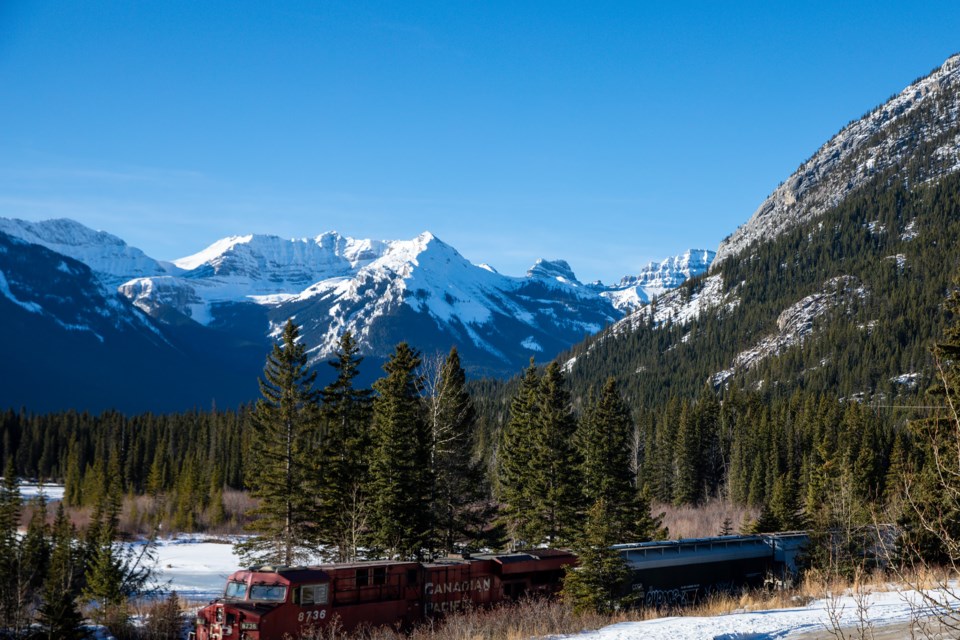BANFF – A campaign is underway to stop trains blasting their horns through the national park townsite.
Residents are signing a petition led by Banff wildlife scientist Tony Clevenger, with plans to ask Banff town council to apply to Canadian Pacific Railway for the creation of a quiet zone through the Banff National Park townsite.
Clevenger said train horns blow in Banff about 200 times a day, which is highly intrusive and can impact people’s physical health and well-being and can cause a range of physiological and behavioural responses in wildlife.
“We can’t remove the trains coming through, but we can silence them,” he said.
Getting CP to stop blowing train horns through town requires a resident to first contact the local municipality. From there, municipalities must consult with the railway company about whether the request is feasible, notify the public if it intends to stop the whistling, and pass a municipal council resolution.
The Town of Canmore went through this process and passed a whistle cessation bylaw in 2006. Clevenger believes it is more than feasible for the same to be done in Banff, where there are two at-grade safety crossings.
“The same train comes through Canmore, which isn’t a national park and UNESCO world heritage site. It goes through silently because the Town requested them to not blow the horn,” he said.
“Banff is trying to be an environmentally responsible town and I think this one is an easy one to do.”
Trains travel through the Banff townsite on average 24 times per day.
Clevenger said train horns blow four times every time they come through town – two times at each at-grade crossing.
He said that equates to almost 200 train horns every 24 hours and more than 70,000 times each year.
“They are coming through at all times of the day and at all times of the night and they’re blowing their horns four times and it’s really loud,” he said.
Clevenger said he has taken sound level readings from the train horns along the railway tracks, which peak at 112 to 121 decibels.
He said readings at Banff Mineral Springs Hospital recorded 72 decibels with peaks at 97, and an apartment three blocks from the tracks had readings of 52 with peaks of 87 decibels.
“I’ve been through documentation and reports and they talk about 50 decibels in the day and 45 at night being the threshold,” Clevenger said.
“I don’t know how people that are living within the first couple of blocks of the railway tracks can endure this.”
A growing body of research indicates noise pollution causes cognitive impairment, distraction, stress, and altered behaviour and physiology in ways that directly influence both wildlife and people.
Studies indicate manmade noise reduces capacity to perceive natural sounds, which are fundamental to survival and reproduction of wildlife.
“We know that noise pollution is an increasing problem worldwide and we know it affects human health and well-being and can cause sleep deprivation, annoyance, irritability,” Clevenger said.
“And in terms of wildlife, it affects species diversity, it affects species distribution and potentially abundance. And the train goes right along the Fenlands-Indian Grounds-Vermilion Lakes, which is an important secondary wildlife corridor.”
The Bow Valley Naturalists (BVN) has thrown its support behind the campaign to stop train horns in town.
One of BVN’s recent goals has been to cut noise impacts on wildlife, such as its work with council on the elimination of fireworks, and to help foster greater nature connections.
“To be a community truly sensitive to environmental considerations also means trying to embrace the more subtle sensory aspects of living in harmony with our natural environment,” said Reg Bunyan, the group's vice-president.
Secondly, BVN is also worried about the long-term integrity of the wildlife corridor between the south side of the Trans-Canada Highway, up to and including the railway lands and those lands on the north side of the townsite boundary.
They say this is an important east-west wildlife movement corridor, which is being whittled away by development such as a dog park, bus garage and parking lots as well as increased human activity and proposals for new gondola infrastructure.
“While we can’t turn the clock back, we feel it is important to continue to attempt to improve the effectiveness of this corridor,” Bunyan said.
From a wildlife mortality perspective, BVN doesn’t believe eliminating the train horn at the two railway crossings in the townsite will have an impact one way or the other.
They say the only possible exception for a preemptive whistle to be blown is in areas of unique terrain where wildlife such as grizzly bears may not hear or see a train coming.
Bunyan said these areas are typically places where steep terrain and curves block the sight and sound of oncoming trains, or where the terrain adjacent to the tracks limits escape options.
“Neither of these are factors in the area between Banff’s two railway crossings,” he said.
In addition, Bunyan said a request to silence the train horn at the controlled crossings doesn’t mean it will never be used.
“Train engineers will continue to sound the horn if wildlife, people or other safety threats are present,” he said. “It just won’t happen automatically, up to 200 times a day, in the same section of habitat”
CP did not offer comment on the petition or how many communities across the country don’t have train whistles blown, but referred the Outlook to Transport Canada’s website for the process on stopping train horns.




